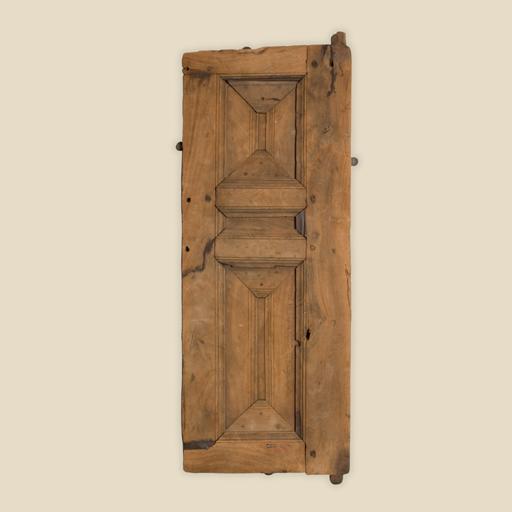With all the recent interest in historically interesting plane designs, I thought it might be interesting to look at a sample of Roman woodwork and see if anyone fancies making a reproduction of it.
Before he published his influential "History of Woodworking Tools" WL Goodman wrote a little book called "Woodwork - from the Stone age to Do-it-yourself" published in 1962.
In it, he illustrated a cupboard door, made by Romans in Egypt at Fayoum, in the 3rd or 4th century AD, which is in the Bristol Museum. He lived in Bristol at the time, so would have been able to pop in and have a look, as I did last week.
Unfortunately, the display is in a sort of 'inside the tomb' gloom, so even after digital lightening, my photo looks like this:

Happily, the museum has its own image on-line which is clearer:

Being a joiner turned historian, Bill Goodman must have been intrigued by the construction of the door. He must have persuaded the curator to let him have a proper look at it, enough for him to have done a detailed measured drawing of it:

It shows some really elaborate work - the horizontal mouldings have been planted into rebates in the panel and secured with dowels. Clear evidence of the existence of effective moulding and plough planes.
It's also interesting for the way that the hinged stile runs through while the shutting stile doesn't, which I think might have helped in fitting the panels into the frame.
What tools were used? Apparently, there is one surviving Roman moulding plane, at the back of this picture, also found in Egypt:

- the sort of practical tool that a craftsman could have made for himself to suit the job in hand, and a pattern which (quite naturally) is still being made from time to time.
Here's the sort of iron that could have been used in it:

So, now that I've given you the background info, are there any skilled plane makers looking for a fresh challenge? A Roman door made with Roman tools?
Or even a similar door with more modern tools?
Before he published his influential "History of Woodworking Tools" WL Goodman wrote a little book called "Woodwork - from the Stone age to Do-it-yourself" published in 1962.
In it, he illustrated a cupboard door, made by Romans in Egypt at Fayoum, in the 3rd or 4th century AD, which is in the Bristol Museum. He lived in Bristol at the time, so would have been able to pop in and have a look, as I did last week.
Unfortunately, the display is in a sort of 'inside the tomb' gloom, so even after digital lightening, my photo looks like this:

Happily, the museum has its own image on-line which is clearer:
Being a joiner turned historian, Bill Goodman must have been intrigued by the construction of the door. He must have persuaded the curator to let him have a proper look at it, enough for him to have done a detailed measured drawing of it:

It shows some really elaborate work - the horizontal mouldings have been planted into rebates in the panel and secured with dowels. Clear evidence of the existence of effective moulding and plough planes.
It's also interesting for the way that the hinged stile runs through while the shutting stile doesn't, which I think might have helped in fitting the panels into the frame.
What tools were used? Apparently, there is one surviving Roman moulding plane, at the back of this picture, also found in Egypt:

- the sort of practical tool that a craftsman could have made for himself to suit the job in hand, and a pattern which (quite naturally) is still being made from time to time.
Here's the sort of iron that could have been used in it:

So, now that I've given you the background info, are there any skilled plane makers looking for a fresh challenge? A Roman door made with Roman tools?
Or even a similar door with more modern tools?




